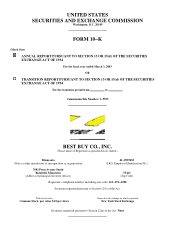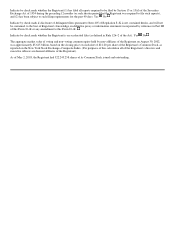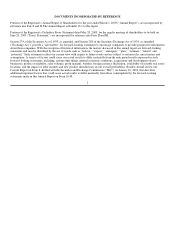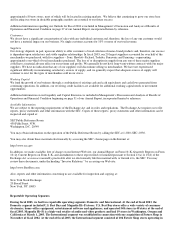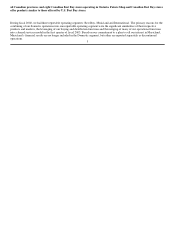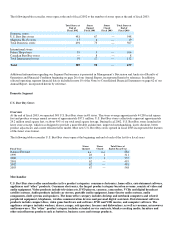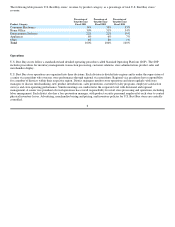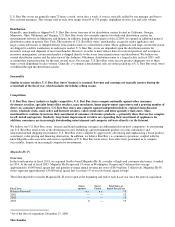Best Buy 2003 Annual Report Download - page 11
Download and view the complete annual report
Please find page 11 of the 2003 Best Buy annual report below. You can navigate through the pages in the report by either clicking on the pages listed below, or by using the keyword search tool below to find specific information within the annual report.
U.S. Best Buy stores are generally open 73 hours a week, seven days a week. A store is typically staffed by one manager and four to
five assistant managers. The average staff in each store ranges from 65 to 150 people, depending on store size and sales volume.
Distribution
Generally, merchandise is shipped to U.S. Best Buy stores from one of six distribution centers located in California, Georgia,
Minnesota, Ohio, Oklahoma and Virginia. U.S. Best Buy stores also currently operate two dedicated distribution centers for
entertainment software in Minnesota and Indiana. In addition, during the first quarter of fiscal 2004, we opened an additional general
distribution center in upstate New York. The majority of U.S. Best Buy stores’ merchandise, except for major appliances and
large−screen televisions, is shipped directly from manufacturers to a distribution center. Major appliances and large−screen televisions
are shipped to satellite warehouses in each major market. U.S. Best Buy stores are dependent upon the distribution centers for
inventory storage and shipment of most merchandise. However, in order to meet release dates for selected products and to improve
inventory management, certain merchandise is shipped directly to the stores from manufacturers and distributors. We believe our
current distribution centers and the relocation of the Ardmore, Oklahoma, distribution center to a larger facility in fiscal 2005, will
accommodate expansion plans for the next several years. On average, U.S. Best Buy stores receive product shipments two or three
times a week depending on sales volume. Generally, e−commerce merchandise sales are either picked up at U.S. Best Buy retail stores
or fulfilled through the distribution centers.
Seasonality
Similar to many retailers, U.S. Best Buy stores’ business is seasonal. Revenue and earnings are typically greater during the
second half of the fiscal year, which includes the holiday selling season.
Competition
U.S. Best Buy stores’ industry is highly competitive. U.S. Best Buy stores compete nationally against other consumer
electronics retailers, specialty home office retailers, mass merchants, home improvement superstores and a growing number of
direct−to−consumer alternatives. U.S. Best Buy stores also compete against independent dealers, regional chain discount
stores, wholesale clubs, mail−order and Internet retailers, video rental stores and other specialty retail stores. Mass
merchandisers continue to increase their assortment of consumer electronics products — primarily those that are less complex
to sell, install and operate. Similarly, large home improvement retailers are expanding their assortment of appliances. In
addition, consumers are increasingly downloading entertainment and computer software directly via the Internet.
We believe our U.S. Best Buy stores’ formats and brand marketing strategies are differentiated from most competitors' by positioning
our U.S. Best Buy retail stores as the destination for new technology and entertainment products in a fun, informative and
noncommissioned shopping environment. U.S. Best Buy stores compete by aggressively advertising and emphasizing a broad product
assortment, value pricing and financing alternatives. In addition, we believe Best Buy’s e−commerce operations, coupled with the
knowledgeable sales associates and service capabilities of U.S. Best Buy retail stores, have effectively positioned us to compete
successfully, despite an increasingly competitive environment.
Magnolia Hi−Fi
Overview
In the fourth quarter of fiscal 2001, we acquired Seattle−based Magnolia Hi−Fi, a retailer of high−end consumer electronics, founded
in 1954. At the end of fiscal 2003, Magnolia Hi−Fi operated 19 stores in Washington, Oregon and California that average
approximately 10,000 retail square feet and generate average annual revenue per store of $6.9 million. Collectively, Magnolia Hi−Fi
stores represent approximately 189,000 retail square feet, less than 1% of our total retail square footage.
The following table reconciles Magnolia Hi−Fi stores open at the beginning and end of each fiscal year since the date of acquisition:
Fiscal Year Stores
Opened Stores
Closed Total Stores at
End of Fiscal Year
Balance Forward* n.a. n.a. 13
2001 — — 13
2002 — — 13
2003 6 — 19
*As of the date of acquisition, December 15, 2000
Merchandise

